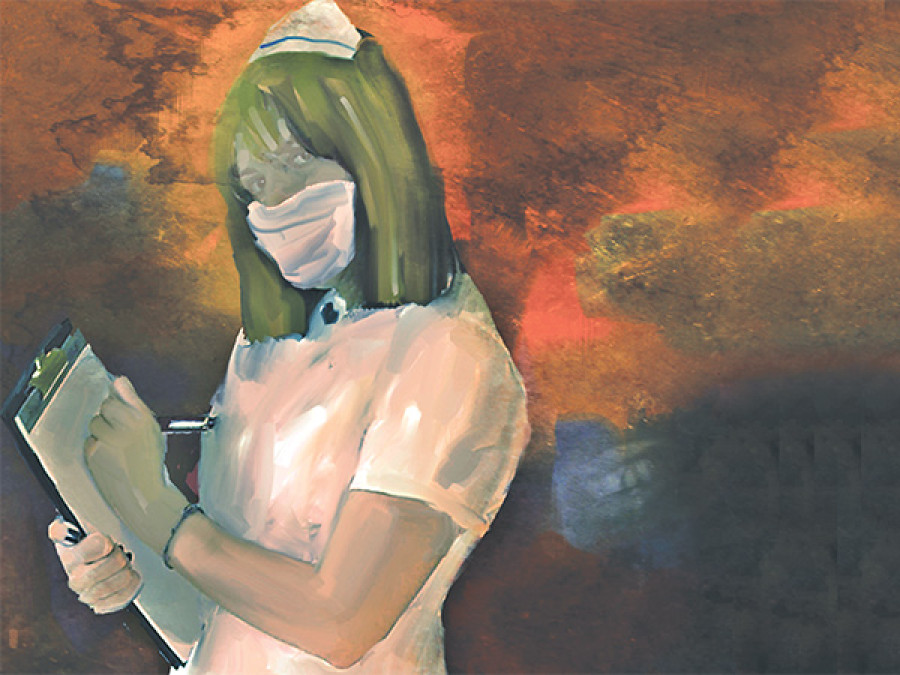Miscellaneous
Nurses say NO
At Himal Hospital in Gyaneshwor, nurse Gyanu (name changed), who completed her bachelor’s programme two years ago, works eight-hour shifts for Rs 1,000
Manish Gautam
At Himal Hospital in Gyaneshwor, nurse Gyanu (name changed), who completed her bachelor’s programme two years ago, works eight-hour shifts for Rs 1,000 every month. The nurse, who does not want to identify herself out of fear of the hospital management, has been working this way at Himal for the last eight months. After so many years, one would expect her to get a full-time position, but the hospital denies that to her, because some other nurses will have to quit for her to get that position.
Gyanu always believed that, after completing her education, she would have a respectful job, a fair salary, and a life that would reward her for her commitment to the nursing field. Two years after graduating, she has no idea what is happening, or what she ought to do.
“This is absolutely atrocious,” says Gyanu, whose parents invested over Rs 1,200,000 for her nursing education. “I am stuck here with no job security, a paltry amount for a salary, and zero opportunities to forge a career.”
Staff nurses at Siddhi Binayak Hospital in Gongabu are in the same predicament: eight staff nurses have been working at the hospital for three months now without any remuneration. Despite this, these nurses work eight-hour periods and are required to invest as much effort into taking care of patients as their full-time counterparts. “Eventually, the hospital will fire us, and we will be a case of neither-here-nor-there,” one of the nurses said.
Stories like these have brought together nurses from different hospitals in Kathmandu to protest against the culture of nurse-volunteerism. Nurses have asserted that ‘forced volunteerism’ is a way to exploit their devotion to academics and learning, and their commitment to the nursing field. The protests culminated last week in the formation of the Anti-corruption Nurse Group. The group demands an entry-level salary of Rs 18,000 for nurses who have completed their bachelor’s degrees.
“Enough is enough,” says Moona Dahal, joint secretary of the group. “We want to make sure that hospitals recognise and respect the value of nurses, and that they immediately put an end to volunteerism. If our demands are not met, we will not lower our voices.”
While the protests continue, it is important to deconstruct this issue. First, the state has to identify the requirement of human resources for the health sector. A report on Health Profession Education Policy, drafted by a Kedar Bhakta Mathema-led committee, has projected that the country will have 125,364 nurses by 2031, which is about 40,000 more than is to be needed, which means that a significant number of nurses around the country will be unemployed. Second, the quality of manpower produced in the country also has to be considered. According to the Nepal Nursing Council, which regulates nursing education in Nepal, around 15 to 20 percent of nurses, who graduate from Nepali nursing colleges and other colleges in places such as Bangalore, fail their licensing examinations.
“It is obvious that hospitals will choose nurses of the highest calibre to be part of their staff,” says Tara Pokhrel, president of the Nepal Nursing Association. “The rest, they will employ as volunteers—this notion has been around for many years. Of course, this attitude has to change, but what is more important is that we nurses ourselves become highly competent.”
However, as agitation brews, the protesting nurses maintain that it is not the quality of nursing that is in question, but rather, the ethical responsibilities of hospitals.
“The council has always declared that nurses should not be asked to work for free. This is completely against international labour laws, and entirely unethical,” says Chandra Kala Sharma, president of Nepal Nursing Council. She also added that currently, the number of nurses being produced is not based on market requirements.
Nursing education began in 1956 in Nepal, and it was eventually institutionalised through the Institute of Medicine in 1971. A major driving factor for students and parents to study nursing was the easy availability of jobs abroad; in foreign markets, easily available nursing jobs also increased access to residency statuses in countries such as the US and Australia. In these very countries, however, following the recession in 2008/09 and protests from nursing unions, these processes have become significantly more complex, thus resulting in a sharp dip in the import of foreign nurses. Some believe that this has compelled Nepali nurses to stay in the country and in an overcrowded market for free, as they have currently been working—as volunteers—until opportunities open up. But with the manpower glut, the volunteer nurses may be in for a long wait. Hospitals have also argued that nurses working for free are gaining experience as full-fledged nurses, hence increasing their chances of employment in the job market later on.
“Nursing care has always been a major component of health systems,” says Sharma. “Thus in order to address the current lack of value that nurses in Kathmandu feel, the government must ensure that hospitals comply with international labour laws and end unethical exploitation of nurses.”




 13°C Kathmandu
13°C Kathmandu










